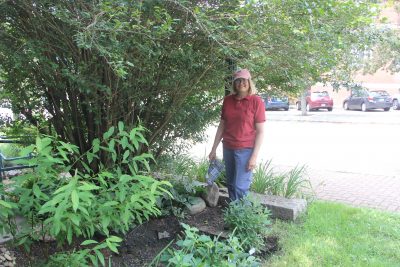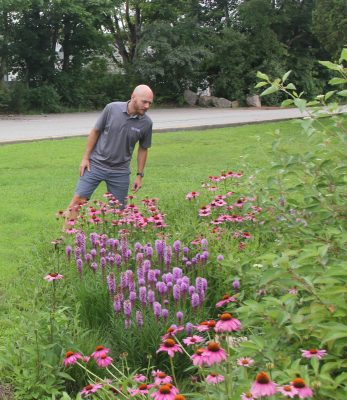
Story and photos by Judy Benson
July’s wet weather may have dampened plans for beach days and barbeques, but it’s also a reminder of an environmental problem homeowners can help solve in their own yards.
The excess of rainfall—about twice the amount normally seen so far this month—means more stormwater tainted with lawn chemicals, oil and gas residues and other pollutants has been entering our streams, rivers and Long Island Sound. The polluted runoff flows off roads, driveways, roofs and parking lots into storm drains that carry it directly into our waterways, untreated, sometimes resulting in high bacteria counts that recently closed swimming areas at Ocean Beach in New London and Rocky Neck State Park in Niantic for a few days.
“A lot of people think stormwater goes to a treatment facility, but most of it just drains directly into a water body,” said David Dickson, faculty member and extension educator for UConn CLEAR (Center for Land Use Education and Research). “Runoff is one of the top water quality problems, especially here in Connecticut.”
But it’s also a problem where small-scale efforts with muscle and a shovel can make a big difference. And thanks to a recently updated, user-friendly app and the added motivation of new state requirements for stormwater—set against all the recent rainfall—there’s no better time for individual action than right now.
Dickson and his colleagues at UConn CLEAR are proponents of rain gardens, an elegantly simple, relatively inexpensive solution that can also enhance outdoor spaces for both people and wildlife. This is basically a bowl-shaped area planted with native grasses, shrubs and flowers tolerant of both extreme wet and dry conditions where runoff is channeled and absorbed into the soil, filtering out pollutants along the way.
Over the past four years, more than 45 rain gardens have been installed at schools, town halls, museums and other public spaces throughout New London and Windham counties, led by the Eastern Connecticut Conservation District. Judy Rondeau, assistant director of the ECCD, quickly ticked off some examples: gardens at East Lyme High School, the Mystic Art Association, Whalen’s Wharf in Stonington, the Groton Social Services Building and the Lebanon Historical Society among them, all collecting runoff from adjacent roofs and pavement.

One of the newest rain gardens in the region can be found at the William A. Buckingham Memorial in Norwich. It was built by Master Gardener Sue Augustyniak as a service project for the Coastal Certificate program, a joint offering of Connecticut Sea Grant, the UConn Master Gardener Program and the Long Island Sound Study. The garden collects water that had been running off the historic home property onto the road, with pussy willow, sweet pepperbush and other plants gracing the shoulders.
“It’s helping keep the Thames watershed clean,” she said. “It’s a great way to help my own community.”
Rondeau encourages people to visit one of the local gardens.
“Seeing them can give people an immediate understanding of where the water’s coming from,” she said, adding that plans are in the works for another 20 rain gardens over the next year.
“Hopefully we’ll be able to get some in this summer, if it ever stops raining,” she joked.
But rain gardens in public places are only part of the solution. Rondeau and Dickson are hoping to spur interest among homeowners to build rain gardens in their own yards. The gardens would not only help solve water issues on their own properties but would also help the cities and towns where they live. Starting this year, all but the most rural towns in the state are required to divert 1% of runoff away from pavement and out of storm drains each year.
“A very easy way to do that is to push rain gardens,” said Rondeau. “It’s a way individual homeowners can make a bit of a difference and beautify a corner at the same time. But even if you don’t like gardening, you can just put in a grass garden. It functions the same.”
So how do you build a rain garden?

That’s where the newly refurbished rain garden app, co-created by Dickson and his CLEAR colleague Michael Dietz, comes in. Launched nine years ago with funding from Connecticut Sea Grant, the updated app is now a web-based tool usable on mobile phones, desktop computers and everything in between. It gives step-by-step guidance on choosing a site, calculating the size, testing the soil, choosing plants and digging the hole the right way to the right depth.
“Especially with some of the heavy, flashy rains we’ve been getting, it’s important to divert as much of that water as possible,” said Rondeau. “It will relieve stress on the storm drain system and direct the water to where it will infiltrate into the soil.”
The free rain garden app can be found at: https://nemo.uconn.edu/tools/app/raingarden.htm.
Judy Benson is the communications coordinator for Connecticut Sea Grant.